Reviews and recommendations are unbiased and products are independently selected. Postmedia may earn an affiliate commission from purchases made through links on this page.
Travel
What to do and see with 2 weeks in Japan
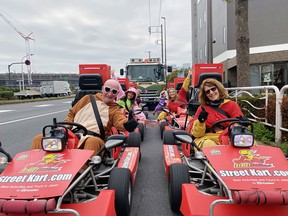
Japan, both the country and the wonderfully friendly people who live there, was an amazing place to visit.
Article content
From go karting round the streets of downtown Tokyo to snow monkeys hanging out in the hot springs of Jigokudani, this is our journal from our April 2024 trip to Japan. (Note: If you are travelling to Japan for seven days or more, purchasing a JR Pass ahead of time is the way to go. The bullet trains are amazing and we also used the pass to get around Tokyo and on buses in other cities.)
Advertisement 2
Article content
APRIL 3
We arrived just after 3 p.m. in Tokyo. Once through the airport we headed to the Japan Rail (JR) ticket exchange to activate our JR Pass voucher (you can buy the vouchers ahead of time in Canada but have to activate them in Japan). Armed with our passes, we headed for the Narita Express, an express train that took us to Tokyo’s main station in less than 45 minutes.
APRIL 4
On the recommendation of our daughter, who visited Tokyo a few years ago, we’d signed up for the Official Street Go-Kart Tour. Basically, you dress up in your choice of costume, from the racks provided, and led by a guide, drive around the streets of Tokyo in Go Karts that can hit 70km/hour.
Our route took us over the famous Rainbow Bridge, past the Tokyo Tower and through downtown Tokyo, before heading back to base 2 hours later. Driving a Go Kart on the streets of Tokyo, surrounded by trucks, buses, taxis and cars, was quite the exhilarating experience.
After Go Karting, we took a train to the Kanda Myojin Shrine. This shrine dates back to 730, but the current series of buildings were built in 1934, following a major earthquake in the area. We then headed to the Tokyo Skytree which soars in the Tokyo skyline and has been fairly described as a combination between the Eiffel Tower and the Seattle Space Needle. The Skytree is Japan’s tallest structure and not surprisingly, the views from the top, of Tokyo at night, were spectacular.
Advertisement 3
Article content
APRIL 5
After an excellent breakfast in our hotel, we headed off to the Tsukiji Outer (Fish) Market. After being completely overwhelmed by the Tokyo train network when we first arrived (likely compounded by the throngs of people all scurrying around), we mastered the network pretty quickly thereafter. And on the odd occasion when we looked somewhat lost gazing at the myriad of signs, we were approached every time by a local offering to help.
Like much of Tokyo, the fish market was complete chaos with vast hives of people milling around a fairly small area. The market comprises one main street and numerous alleys and side streets filled with vendors selling their fresh catch, sushi and various other edibles. We purchased a giant shrimp cracker (almost like a poppadom). Very tasty.
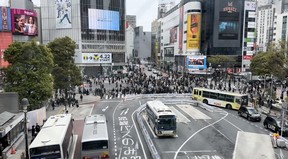
Next we headed to the world-famous Shibuya Crossing. Without doubt its claim to be the busiest crossing in the world was fair; as many as 3,000 people cross the six-intersecting crossings at any one time. After making a couple of crossings ourselves, we sat at one of the food courts in the area, where the spectacle of the crossing can be viewed from above.
Article content
Advertisement 4
Article content
After lunch we headed to Yoyogi Park, which is a pleasant oasis of trees and gardens, headlined at the far end of the park by the Meiji Shrine. It’s a very peaceful and tranquil setting and a nice place to unwind after the bedlam of downtown Tokyo.
Our final destination took us to the gardens surrounding the Imperial Palace. While the palace is not open to the general public, the gardens are accessible and feature a variety of trees and plants, a moat and wall surrounding the palace (oh, and one solitary swan).
This completed our whirlwind visit to Tokyo – chaotic but well worth the experience. We then took the Shinkansen train to Shizuoka, which reaches speeds of more than 300km/hour, and checked in to our hotel, which was located right at the station.
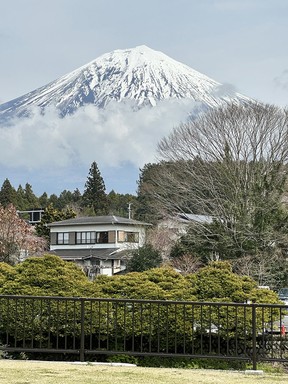
APRIL 6
We’d been told that Mount Fuji is only visible if the skies are clear, and although we woke up to overcast conditions, we rented a car and headed to the Mount Fuji area. Barely 30 minutes into the journey, Fuji popped out of the clouds.
Our first stop in the region was the Fujisan Sengen Shrine, which dates back more than 1,000 years and is the region’s most important shrine out of more than 13,000 Sengen and Asana shrines in the region. It is often the starting point for those wishing to climb Mount Fuji and is home to more than 500 cherry trees, all of which were in full blossom, together with a number of delightful ponds, laden with koi. It’s a popular spot for wedding party photos and there were quite a few groups there.
Advertisement 5
Article content
We then went to see a couple of nearby waterfalls – the Shiraito Falls and the Otodome Falls – got some great pictures of the falls and Mount Fuji.
We then completed our Fuji outing by visiting some of its surrounding lakes, including Taruki, Motosu and Shoji. The latter two are part of the five-lakes group featured around Mount Fuji, of which Motosu is the third largest and one of the ten deepest lakes in Japan. Shoji is the smallest and was at one time part of Motosu, but was separated in the 9th century by lava flow when Mount Fuji erupted.
We then headed back to Shizuoka and boarded the bullet train to Nagoya, our stopping point for the night.
APRIL 7
Today was set aside for a trip to see the Formula 1 race in Suzuka, which is about a 50-minute train ride from Nagoya, followed by a 20-minute shuttle bus from the nearest station to the circuit, Shiroko.
With more than 200,000 fans attending the weekend event, the organization for the F1 event was spectacularly good. As soon as we disembarked from the train, we were guided by a large contingent of volunteers through a maze of chained off routes to get to the shuttle buses, which in turn took us to the circuit.
Advertisement 6
Article content
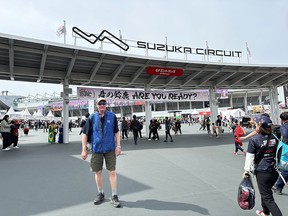
The weather cooperated and we had a great day. We were back at our hotel within two hours of the race finishing and had a lovely meal nearby in one of the little side streets, before calling it a night.
APRIL 8
We left Nagoya early in the morning and used our JR Pass to travel to Kyoto, our base for the next three nights. Once we’d dropped off our bags at the hotel we headed back to the station and boarded a train to Nara. This lovely little town’s main highlights are its numerous historic temples, the Nara Park, and the hundreds of deer that wander around the park.
Our first stop was the Kohfukuji Temple, which is one of Japan’s oldest and most famous Buddhist temples, dating back to the 8th century.
From there we headed to the park and were immediately greeted by the resident deer. Vendors (human that is, not deer) sell deer biscuits and the deer are well aware of this. And in keeping with Japanese tradition will bow their heads, in anticipation of a treat.
The park is very sizeable and a lovely place to wander around, and home to many temples and shrines. The first temple we visited in the park was the Todai-ji, originally founded in the 8th century but reconstructed several times since. The most significant reconstruction occurred in 1709 with the construction of the Great Buddha Hall. This houses the world’s largest bronze statue of the Buddha Vairocana.
Advertisement 7
Article content
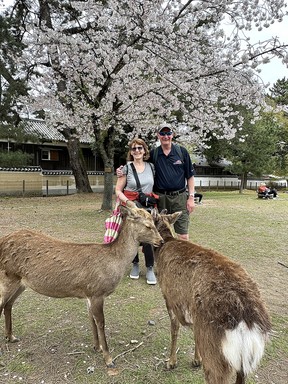
All of these shrines are in the park, and there are also many beautiful treed routes; we wandered through some of these on our way back, always with deer in close proximity. Our last stop off point was the Ukimido Gazebo, home to a small lake and the most-spectacular array of cherry blossom trees, all in full bloom.
Sharon and I both agreed that Nara was our favourite – it’s absolutely delightful.
APRIL 9
We decided we would limit our Osaka day to two primary landmarks. The first of these was the Umeda Sky Building, which comprises two 40-storey towers which are connected by glass bridges crossing the towers’ atrium space. A glass lift takes you up the first 39 floors and then an escalator takes you up to the sky deck. It was quite the engineering marvel at the time; the sky deck, after construction, was raised to the top of the building using a set of hydraulic elevators.
After leaving the Sky Building, we headed out to see the Osaka Castle – Osaka’s primary attraction. The castle was built in 1583 by a warlord who unified Japan. The castle has been reconstructed several times over the years, most recently about 100 years ago, and includes a museum covering seven floors, culminating in an open-viewing platform on the eighth floor. The walk from the station to the castle was also really nice with all the cherry blossoms and the moat surrounding the castle.
Advertisement 8
Article content
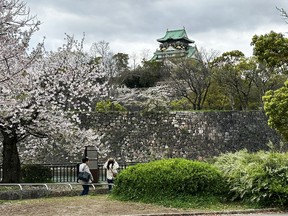
A lovely day but not as much to see and do as the other places we have visited so far and possibly a half day would suffice.
APRIL 10
Today we stayed in Kyoto and made use of the Hop On Hop Off bus. Our first stop was the Nijo-jo Castle, built in 1679, and one of the many World Heritage sites designated in Kyoto. We started our tour by going through the Ninomaru Palace, which is a fascinating series of buildings decorated with numerous carvings and paintings. One of the interesting features is the sound made when walking inside the building – like Nightingales singing – it was left this way after construction so that any intruders could be heard if they entered. The sound comes from the hinges used in the construction.
We then took the bus to the Kinkaku-ji Temple (also known as the Golden Pavilion). This building is set in magnificent grounds and dates back to the 14th century. Although the original structure was destroyed by fire, the reconstruction that took place in 1955 is apparently very close to the original. You can’t actually go in the temple, but the walk around it and through the gardens was well worth the stop.
Advertisement 9
Article content
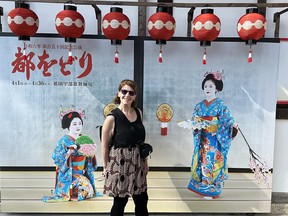
Our last stop was the Gion District, home of the geishas. This is a busy area full of shops and narrow side streets but still finds space for the beautiful Maruyama Park. As well as housing several wild cats, it is, of course, full of cherry blossom trees and a lake, home to a number of koi which were being eagerly watched by a lone heron. Lots of food vendors had set up stalls in the park as there are festivals to commemorate the cherry blossom season.
APRIL 11
Our journey today took us to Arishiyama, barely a 15 minute ride out. After stopping at a café near the station for breakfast, we walked up a few narrow streets before emerging at the entrance to the Bamboo Forest. As its name suggests, it’s a natural forest of bamboo trees and includes the Sogenchi Gardens and the Tenryu-ji Temple.
After the gardens we continued through the Bamboo Forest heading to the bridge that goes over the Katsura River. The Togetsuko Bridge was originally built in the 9th century and leads to the entrance to the Iwatayama Monkey Park, the other big attraction is Arashiyama.
There is a bit of a climb (like doing the Coquitlam Crunch) required to get to where the monkeys hang out but worth it if you want to see Macaques wandering around. There are about 120 of them in this area and, although they are wild and can go wherever they want, they are content to hang out in this particular location during the day as they know that there is a constant source of peanuts and fruit to be had, purchased by tourists from vendors at the top of the trail. These treats are fed to the monkeys by dropping the food in front of them, but we encountered one particular monkey who threw back the peanuts, preferring instead the fruit that he knew we had.
Advertisement 10
Article content
Then back to the station to head back to our hotel in Kyoto to pick up our bags and head to our next destination, Kanazawa.
Although this is more than 260 km away, the bullet train gets you there in under two hours. The only hitch is that the journey requires a change of trains in Tsuruga, and with barely seven minutes between trains and two levels to navigate from the incoming track to the departing track, it led to a scene akin to an episode from the Amazing Race, with passengers racing through the station.
APRIL 12
We spent today exploring Kanazawa, located in Central Honshu. We got off the bus first at the Kenrokuen Gardens, which are stunning, and have been voted one of the top gardens in Japan. The gardens include ponds, tea houses, a maze of different paths and, of course, numerous cherry trees. The gardens were opened to the public more than 150 years ago and are absolutely worth the visit.
After leaving the gardens, we crossed to the site of the Kanazawa Castle. Originally constructed in the 6th century, most of the buildings are reconstructions to reflect how the castle looked in the mid 19th century; although the main keep was never replaced after it was destroyed by fire in 1602.
Advertisement 11
Article content
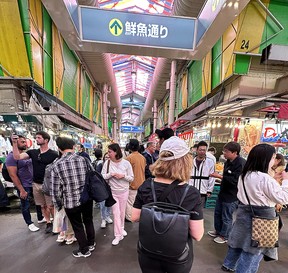
Next up was an ice cream cone wrapped in a sheet of gold leaf, which is unique to Kanazawa.
We finished our day with a stop in the Omicho Market, where vendors ply their trade, mainly seafood. However, we treated ourselves instead to a skewer of Wagyu beef, which was so tender.
Then back to the hotel to retrieve our bags. And once again take the bullet train, this time to Nagano.
APRIL 13
Today’s stop was Togakushi, which is about a 45-minute bus ride outside of Nagano, winding up narrow mountainous roads and reaching an elevation of about 1,200 metres. This is a beautiful part of Japan and the Togakushi area features five main shrines and a beautiful cedar-lined trail of more than two kilometres leading to the Okusha Shrine. It was still snowy and icy near the top but a magnificent setting for a hike.
After completing our hike, we caught the bus down to the main shrine; the Chusha shrine. (The bus does the loop once every hour so you have to get your timing right.) This shrine is set in the middle of the Togakushi area and has a number of small cafes in and around the shrine. We were told that we had to try a bowl of soba noodles, as this area is famous in Japan for soba.
Advertisement 12
Article content
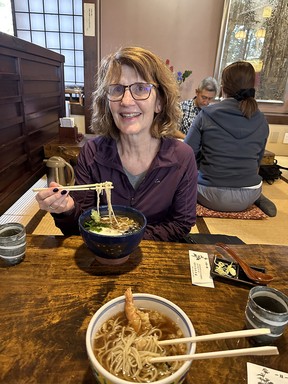
The noodles are made primarily from buckwheat flour and the main chef at the café that we chose took a shine to us when he heard we’d travelled from Canada to sample his noodles. After bringing us the noodles, he also brought the kettle of water that the noodles had been boiled in and urged us to drink the water as “very good for health.’
We then took the bus back towards Nagano, stopping off at the Zenkoji Temple. This temple is one of the most important in Japan, dating back to the 7th century and is home to the first Buddha statue brought to Japan.
APRIL 14
Our last full day in Japan took us to the Jigokudani Monkey Park, about a 45-minute bus ride from Nagano. After the bus ride, a 45-minute walk is required to take you up to where the monkeys hang out. As in Arashiyama, these are Macaques, and they like this particular area in the day for two main reasons. First, particularly in the winter, but also all year round, they come down the steep cliffs to enjoy the warm waters of the natural onsen (hot springs) before returning to their mountain retreat in the evening. The other reason they venture down is that they know the park attendants will throw down some seeds for them.
Advertisement 13
Article content
Even before we got to the official entrance to the park, we encountered several monkeys making their way in for their snack (no admission fee required for the primates).After dining, some of the monkeys headed off to the hot spring area for a relaxing sit in the onsen. Others decided it was nap time.
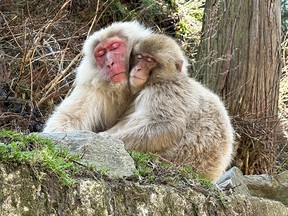
After leaving they park, we decided we would take a local bus to Shibu Onsen village. As its name implies, this village is home to several onsens and also has a few that are specifically for feet only.
After that, we caught the train back to Nagano, enjoyed our last meal in Japan, and readied ourselves for the long journey home.
Article content


)






